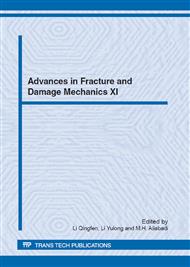p.557
p.561
p.565
p.569
p.573
p.577
p.581
p.585
p.589
Dynamic Response Analysis of Lining Structure with Primary Defects for Tunnel under Moving Train Loading
Abstract:
Considering the background of vibration engineering of lining structure of subway tunnel with primary defects under moving train loading, and according to the measured information of a dynamic loading spectrum of subway in Beijing, dynamic response of the lining structure with differently primary defects caused by neighboring tunnel construction has been investigated for different cases including one-way and two-way trains in this paper. The results show that the curves of dynamic time history analysis are similar with each other for displacement and stress under different cases with differently primary defects. The peak value of displacement and stress under the case of two-way train is much larger than that under the case of one-way train, and the structure primarily depends on tensile strength of concrete in safety. Under the case of one-way train with primary defects would there be no defect by vibration loads.
Info:
Periodical:
Pages:
573-576
Citation:
Online since:
November 2012
Authors:
Keywords:
Price:
Сopyright:
© 2013 Trans Tech Publications Ltd. All Rights Reserved
Share:
Citation:


